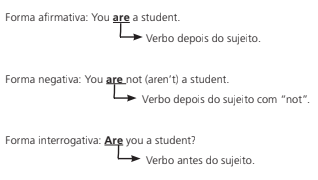VERB TO BE


Exemplos:
I’m Brazilian.
She’s a very intelligent girl.
They are engineers at Petrobras.
You are on the 10th oor.
I’m not in São Paulo now. I’m in Rio.
He isn’t a good soccer player.
We are not doctors, we are engineers.
Are you a scientist at Instituto Vital Brasil?
Are they near the beach?
Is it a good Hospital?
VERBOS THERE IS, THERE ARE
Os verbos There is, There are estão no tempo presente e equivalem ao verbo haver no sentido de existir em português. There is é usado antes de coisas ou pessoas no singular, e there are é usado antes de coisas ou pessoas no plural.
As formas dos verbos there is e there are são:

Exemplos:
There is much information on TV.
There are many students in that school.
There isn’t any car in the garage.
There aren’t many people in the stadium.
Is there much sugar in the pot?
Are there three rooms in that house?
VERBOS NO PRESENT CONTINUOUS/PROGRESSIVE
O Present Continuous ou Progressive indica uma ação que está em progresso no momento da fala. Também pode indicar ações temporárias no presente, ações futuras e acontecimentos que parecem
infindáveis no presente (hábitos irritantes).
A conjugação do “present continuous” é:

FORMAÇÃO DO PRESENT CONTINUOUS OU PROGRESSIVE

Ação ocorre no momento em que se fala.
Exemplo:
What are you doing now? I’m xing my father’s car.
Listen! Somebody is knocking at the door.
What is that music you’re playing?
Ação temporária que ocorre num período de tempo no presente, mas não necessariamente no momento em que se fala.
Exemplos:
Paul is reading a book of Jorge Amado.
The U-2 is performing at Maracanã.
People are eating less meat nowadays.
Indicar uma ação futura.
Exemplo:
Hurry up! The plane is leaving soon.
She is visiting her mother in Niterói tomorrow.
I’m on vacation at the moment, but I’m starting a new course next week.
Descreve e enfatiza uma série de acontecimentos infindáveis.
Nesse tipo de ação geralmente usamos advérbios como “always, forever or constantly” e outros advérbios de frequência.
Exemplo:
She’s always trying to show that she knows more than everyone else.
I’m constantly having to remind you to tidy up your things.
Formação do sufixo “ing” com alguns verbos:
• Verbos de uma só sílaba, terminados por consoante precedida de uma única vogal, dobram essa consoante para o acréscimo de –ing:
beg begging
hit hitting
stop stopping
• Verbos teminados em –e perdem o –e para o acréscimo de –ing:
bake baking
love loving
rise rising
• Verbos terminados em –ee conservam essa terminação para o acréscimo de –ing:
agree agreeing
flee fleeing
see seeing
• Verbos terminados em –ie perdem essa terminação e recebem –y antes da colocação de –ing:
die dying
lie lying
tie tying
• Qualquer verbo terminado em –y é simplesmente acrescido de –ing:
obey obeying
study studying
play playing
cry crying
• Verbos terminados em –l precedido de uma única vogal dobram essa consoante para o acréscimo de –ing (regra válida para o inglês britânico); quando o –l for precedido de duas vogais, a duplicação não é efetuada:
label labelling
steal stealing
feel feeling
• Verbos com mais de uma sílaba, terminados por consoante precedida de apenas uma vogal, dobram essa consoante, se o acento tônico recair na segunda sílaba; se não, apenas recebem –ing:
begin beginning
permit permitting
master mastering
open opening



